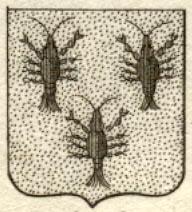Fish in Heraldry
In general, there is no specific meaning associated with charges. However, medieval and early Modern culture did make associate some animals with virtues or characteristics, and this symbolism can sometimes explain the use of a charge. For example, the lobster was thought to be the enemy of serpents and hence a symbol of temperance (the serpent being associated with sin, cf. Genesis). The crab, because of its capacity to move sideways, was seen as a symbol of inconstancy. More often, however, a peculiar animal was chosen for a play on words.Believe it or not, there is a whole book on the subject: Thomas Moule: The Heraldry of Fish. London, 1842; J. Van Voorst.
Crabs, Crawfish, Lobsters
In English heraldry the lobster is not found, but lobster claws occur. Lobsters are also rare in continental heraldry, but crawfish (ecrevisses in French) and crabs are more common. They are usually shown in pale. Confusion often arises as to which animal is being depicted, so that blazons sometimes name the charge crab, crawfish, lobster or even scorpion.
Here are some examples:
- Tregarthick (Cornwall, Devonshire): Argent two lobster's claws in saltire gules the dexter surmounting the sinister.
- Kerne (UK): Argent a chevron between three lobster's claws gules.
- Von Melem (Frankfurt): Argent a lobster gules.
- Die Gergelase: Azure a lobster in bend bules.
- Atwater (UK): Barry wavy of six argent and gules, six crevices (alias six dolphins, alias three crawfish) or two and one. Atwater, bishop of Lincoln (†1520) was granted the following arms in 1509: Barry wavy ermine and gules, on a chevron between three crayfish gules a rose between two lillies gules, stalked vert.
- Atsea of Herne (Kent): Barry wavay of six or and gules three prawns naiant in the first of the second.
- Grilla (Spain): Gules on a bend or a lobster (alias three lobsters) sable. (this may be a misreading for a cricket, grillo in Spanish).
- Platen (Saxony): Azure a crawfish in bend gules and addexter three stars argent.
- Roujoux (Brittany): argent a crawfish gules.
- Aleschamps: Or a chevron between three crawfish gules.
- Boucher de la Rupelle (Champagne): Argent three crawfish gules.
- Thiard, marquis de Bissy (Burgundy, Brittany): Or three crawfish gules.

- Tarteron (Lorraine): or a crab sable, on a chief azure three stars or five points
argent.

Examples of canting arms (in German, Krabbe=crab, Krebs=crawfish; in Italian, gambero=crawfish):
- Nicolas de Cusa (1401-64, from Trier, family name Krebs; as shown on his tombstone in S. Pietro in Vincoli, Rome): Or a lobster (sic Woodward, probably a crawfish) in pale gules.
- Crab of Robslaw (Scotland): Azure a chevron argent between two fleurs-de-lis in chief and a crab in base or.
- Crabbe (Flanders): Azure a crab or.
- Crabben (Holland): Argent three crabs in fess gules, 2 and 1.
- Krebser (Switzerland): Argent three crawfish gules.
- Krebsberg (Franconia): Or a crawfish in pale gules issuant from water in base vert.
- Gambara (Venice, ennobled 1653): per fess, argent an eagle displayed sable crowned or, or a crawfish in pale gules.
- Gambari (Tirol): Or an eagle sable seizing a crawfish gules.
- Gambarelli (Rimini), Gambari (Bologna), Gambarini (Forli), Gambera (Monferrato) and Minghetti (Bologna) have crawfish in their arms.